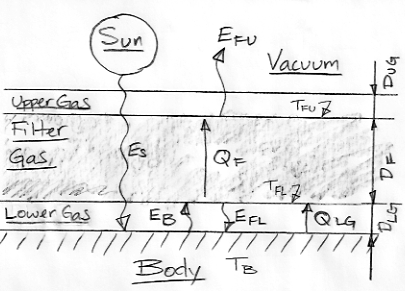
By radiative symmetry, the Upper Gas radiates no heat. Nor can it transport heat into the vacuum by convection or conduction. The temperature of the Upper Gas is constant, so it cannot be gaining or losing heat. It must be at the same temperature as the upper surface of the Filter Gas, which is TFU.
Thermal equilibrium for the entire system dictates that QF = EFU = ES. In our previous post we assumed ES = 350 W/m2 for similarity with the Sun and the Earth, and we showed how Stefan's Law dictates that TFU = 280 K.
We also assumed QF = KF(TFL−TFU) and we chose KF = 4.4 W/m2K. But this equation for QF says nothing about the depth of the filter. Let us now relate the heat flowing through each gas layer to its depth with a single coefficient, k, with units of W/mK.
QF = k(TFL−TFU)/DF, QLG = k(TB−TFL)/DLG
For k, let's choose 350 W/m2 / 80 K × 10 km = 44 kW/mK. We choose 80 K because that's roughly the drop across the Earth's troposphere, and we choose 10 km because that's roughly the altitude of the Earth's tropopause. With DF = 10 km and QF = 350 W/m2 we have TFL−TFU = 80 K, so that TFL = 360 K.
Let us consider thermal equilibrium at The Body surface. We must have ES + EFL = EB + QLG. We apply Stefan's Law to obtain the following.
ES + σ(TFL)4 = σ(TB)4 + k(TB−TFL)/DLG
Where σ = 5.7×10−8 W/m2K4 and k = 44 kW/mK. Suppose we assume DLG = 1 km. We have already calculated that TFL = 360 K, so we arrive at the following relation for TB.
(TB)4.(5.7×10−8 W/m2K4) + TB.(44 W/m2K) = 17 kW/m2
The solution to this equation is TB = 366.4 K = 94.5°C. With a vacuum in place of the Lower Gas, we found TB = 390 K = 117°C. Thus the addition of the Lower Gas reduced the temperature of The Body by 24°C. At this temperature, EB = 1.03 kW/m2 and EFL = 960 W/m2, so that The Body is radiating 70 W/m2 more heat to the Filter Gas than the Filter Gas is radiating back to The Body. But QLG = 280 W/m2. Convection accounts for 80% of the net 350 W/m2 passing from The Body to the Filter Gas. Imbalance in radiative transfer accounts for only 20%.
In future posts, we will see how our three-layer gas model can be used to approximate heat transfer through the Earth's atmosphere, and allow us to estimate the influence of carbon dioxide concentration upon the Earth's temperature.

No comments:
Post a Comment